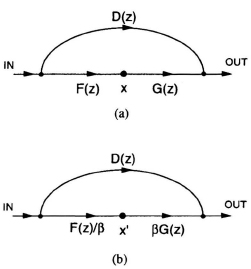11.2 SCALING AND ROUNDOFF NOISE
11.2.1 Scaling Operation
Scaling is a process of readjusting certain internal gain parameters in order to constrain internal signals to a range appropriate to the hardware with the constraint that the transfer function from input to output should not be changed.
The filter in Fig. 11.1(a) with unscaled node x has the transfer function
![]()
To scale the node x, we divide F(z) by some number β and multiply G(z) by the same number as in Fig. 11.1(b). Although the transfer function does not change by this operation, the signal level at node x has been changed. The scaling parameter β can be chosen to meet any specific scaling rule such as


where f(i) is the unit-sample response from input to the node x and the parameter δ can be interpreted to represent the number of standard deviations

Fig. 11.1 (a) A filter with unscaled node x and (b) A filter with scaled node x′.
representable in the register at node x if the input is unit-variance white noise. If the input is bounded by |u(n)| ≤ 1, then
Equation (11.4) represents the true bound on the range of ...
Get VLSI Digital Signal Processing Systems: Design and Implementation now with the O’Reilly learning platform.
O’Reilly members experience books, live events, courses curated by job role, and more from O’Reilly and nearly 200 top publishers.

